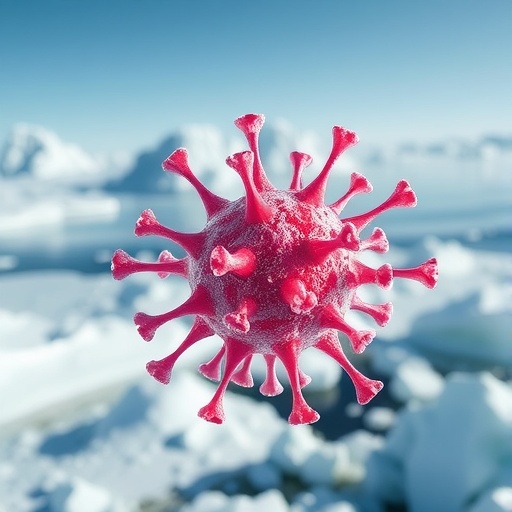Antarctic marine viruses represent a captivating frontier in polar microbiology, revealing intricate ecological dynamics that shape some of Earth’s most extreme environments. Recent scientific syntheses underscore the profound roles these viruses play across diverse Antarctic marine habitats, ranging from sea ice to surface waters and the deep ocean. Despite the harsh conditions, viral populations thrive, exhibiting remarkable diversity and adapting through sophisticated infection strategies that influence microbial community structures and biogeochemical cycles on a global scale.
The Antarctic marine virome includes both DNA and RNA viruses, with the latter emerging as an underexplored yet crucial component of the ecosystem. RNA viruses, though less characterized than DNA viruses such as the Caudovirales order, appear to have seasonal fluctuations that closely mirror phytoplankton blooms. This temporal correlation suggests that RNA viruses are not merely passive residents but active modulators of microbial population dynamics, affecting carbon flow and energy transfer through the polar food web with potential repercussions for the global carbon budget.
Viral infection in these polar waters primarily proceeds through dual strategies: lytic cycles, whereby infected cells rupture releasing new virions, and lysogenic pathways, where viral genomes integrate into host DNA, lying dormant until triggered. These infection modes vary dynamically throughout seasonal phytoplankton blooms, altering viral community composition and infection outcomes. Understanding these mechanistic shifts is essential to unraveling Antarctic viral ecology and its impact on nutrient cycling and microbial mortality rates in this sensitive region.
One of the most significant ecological functions of Antarctic marine viruses is their contribution to nutrient regeneration through viral lysis. When viruses lyse their microbial hosts, cellular constituents including carbon, nitrogen, and trace metals such as iron are liberated back into the surrounding waters. This process rejuvenates the nutrient pool, supporting microbial growth and sustaining the trophic networks driving Antarctic food webs. Of particular interest are auxiliary metabolic genes (AMGs) carried by some viruses that can manipulate host metabolic pathways, conferring adaptive advantages to survive extreme cold and low nutrient availability.
Despite these advances, considerable knowledge gaps persist, especially regarding viral diversity in the Southern Ocean. The marginal ice zone (MIZ), characterized by intense chemical gradients and seasonal productivity shifts, remains a critical yet under-studied viral habitat. Future research targeting this high-variability zone is paramount, as it could reveal how viral-host interactions respond to climate-driven changes in sea ice extent and water chemistry, thus informing predictions about ecosystem resilience under global warming.
Technological innovations such as viral tagging with fluorescent markers and single-cell RNA sequencing offer promising avenues to identify specific virus-host pairs in Antarctic waters. These high-resolution approaches can delineate infection networks, clarify viral contributions to microbial mortality, and elucidate virus-driven gene transfers. Such fine-scale understanding is vital to modeling the microbial loop and assessing how viral dynamics govern carbon sequestration processes in polar oceans.
Projection models suggest that climate change will profoundly influence Antarctic marine viral ecology. Rising temperatures and fluctuating sea ice coverage are expected to alter the balance between lytic and lysogenic infection modes, shift viral community structure, and impact the timing and magnitude of phytoplankton blooms. These changes could cascade through microbial communities, modifying biogeochemical fluxes and potentially diminishing the Southern Ocean’s capacity as a carbon sink, with implications extending to global climate regulation systems.
The study of Antarctic marine viruses not only advances basic understanding of polar microbiomes but also has broader significance in marine virology and ecosystem science. Viruses drive microbial diversity, promote horizontal gene transfer, and regulate microbial population dynamics, forming an essential but invisible backbone of oceanic food webs. In Antarctica, these processes unfold under some of the most challenging environmental conditions on the planet, offering insights into viral adaptation, resilience, and their role in sustaining life in extreme ecosystems.
Researchers from the University of Tasmania and Ocean University of China, leveraging interdisciplinary collaboration, have synthesized existing knowledge to identify priority areas for future exploration. Their comprehensive review highlights the urgent need for expanded sampling across understudied regions, refined molecular techniques for viral detection, and integrative climate modeling to anticipate ecological trajectories. This strategic approach will fill critical gaps in the understanding of viral-mediated nutrient cycling and ecosystem functioning in the Southern Ocean.
Moreover, the investigation into viral auxiliary metabolic genes is unveiling an unexpected layer of complexity in virus-host interactions. AMGs can modulate host metabolic processes such as photosynthesis, nitrogen assimilation, and stress responses, effectively optimizing host survival and viral replication under Antarctic extremities. These viral genes may orchestrate microbial community responses to environmental stressors, adding a functional dimension to viral ecology that challenges traditional views of viruses solely as predators or genetic parasites.
Understanding the patterns and mechanisms of viral infection within the dynamic context of Antarctic phytoplankton blooms is also key. Viruses impose top-down control over dominant microbial species, shaping bloom propagation and collapse. This topological regulation not only influences local ecosystem productivity but also impacts carbon export to the deep ocean via the biological pump. Detailed temporal and spatial viral monitoring during bloom events stands to refine predictive models of polar carbon cycling under evolving climatic scenarios.
The Antarctic marine environment serves as a natural laboratory for studying virus-driven ecological processes under rapid environmental change. The interplay of viral diversity, infection strategy, host interaction, and environmental modulation in this remote region offers paradigmatic lessons for understanding how viruses mediate ecosystem resilience and planetary biogeochemical cycles. As the climate crisis accelerates, unraveling these viral mysteries is essential for anticipating the future health and functionality of polar oceans and the global environment they influence.
Subject of Research: Antarctic marine viruses and their ecological roles in polar ecosystems.
Article Title: Antarctic Marine Viruses: A Review and Future Perspectives
News Publication Date: 29-Jul-2025
Web References: http://dx.doi.org/10.34133/olar.0101
Image Credits: Chuan Zhai, Fraser Kennedy & OLAR
Keywords: Marine biology, Marine ecosystems, Marine ecology, Marine life




